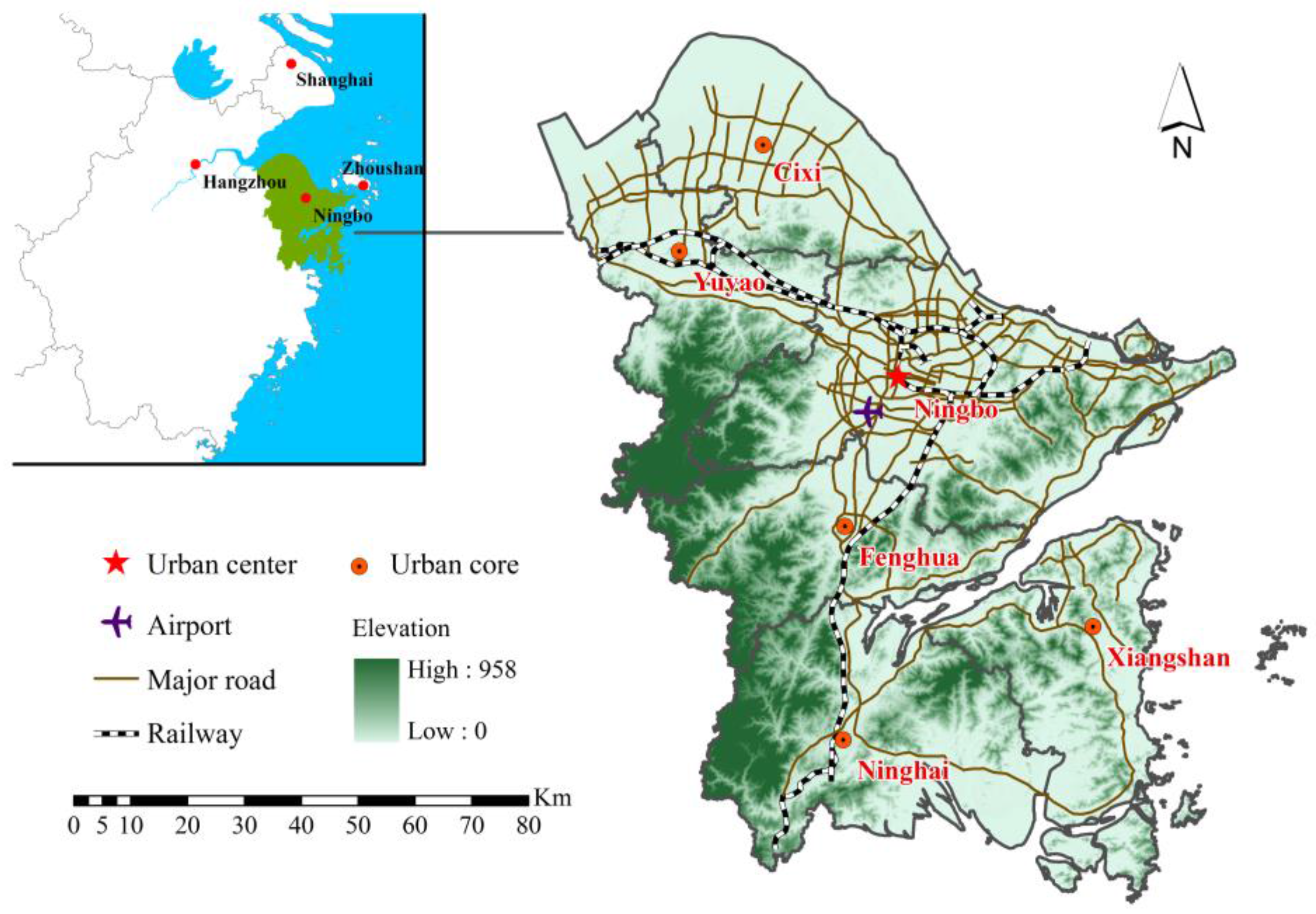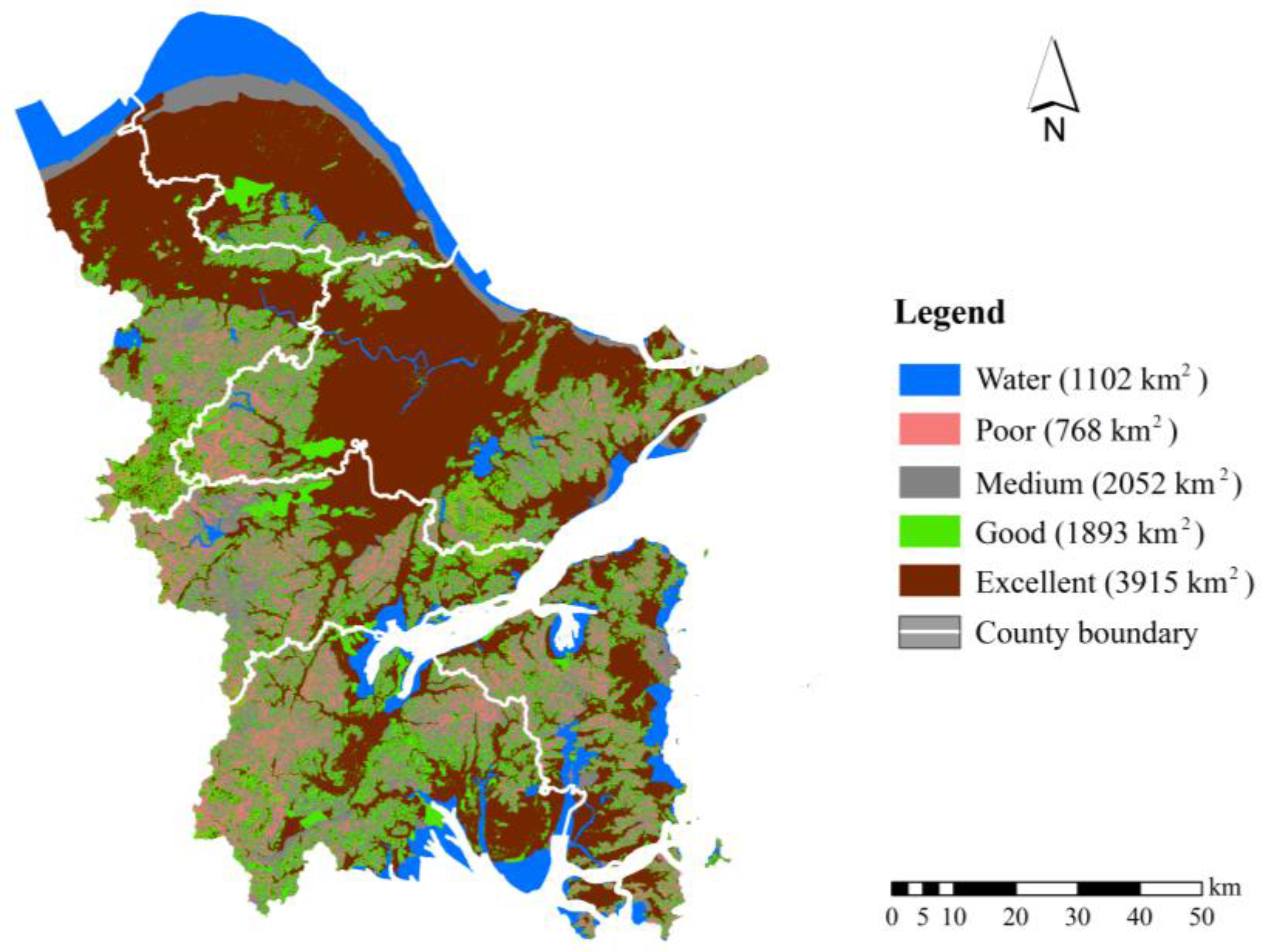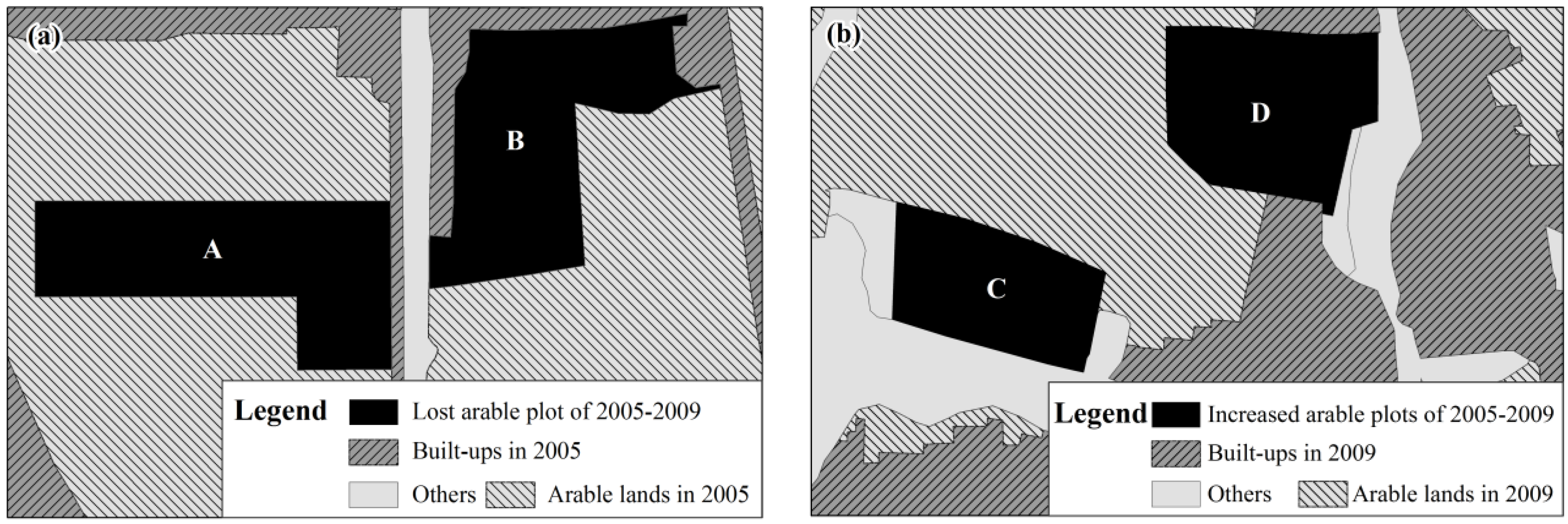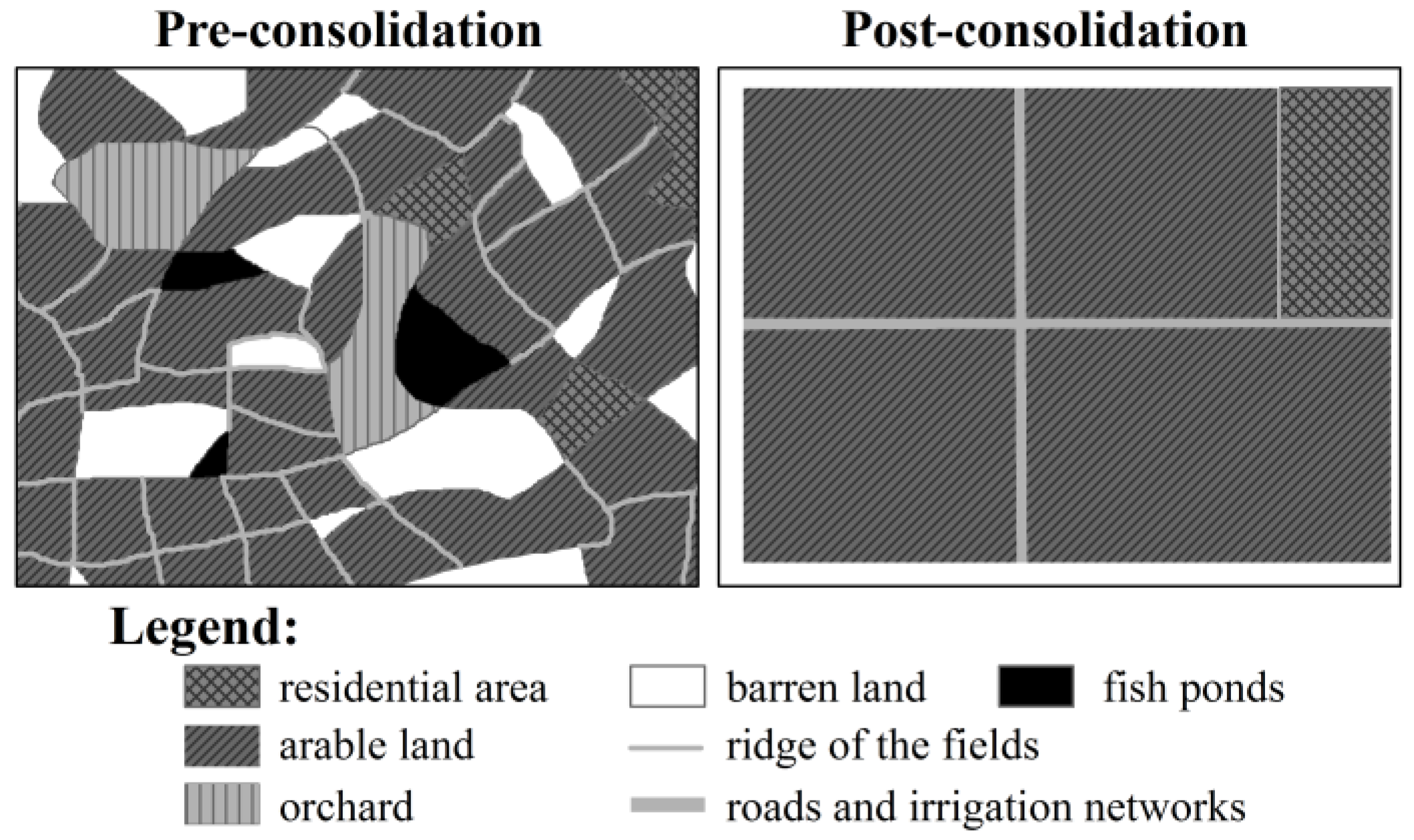Assessment on the Impact of Arable Land Protection Policies in a Rapidly Developing Region
Abstract
:1. Introduction
2. Study Area and Database
2.1. Study Area
2.2. Data and Preprocessing
3. Method
3.1. Soil Quality Assessment
3.2. Landscape Metric Analysis
4. Results
4.1. General Characteristics of Arable Land Changes
4.2. Terrain Comparison between Lost and Increased Arable Land
4.3. Soil Quality Comparison between Lost and Increased Arable Lands
4.4. Spatio-Temporal Pattern Comparison between Lost and Increased Arable Lands
5. Discussion
5.1. Critical Issue of Arable Land Loss
5.2. Source of Arable Land Increases
5.3. Estimation of the Quality of Arable Land Change
5.4. Spatial Pattern Characteristics of Arable Land Transformations
6. Conclusions
Acknowledgments
Author Contributions
Conflicts of Interest
Abbreviations
| PD | Patch density |
| MPS | Mean patch size |
| AWMSI | Area-weighted mean shape index |
| GIS | geographic information systems |
| USGS | U.S. Geological Survey |
| Ca | Adjacency of arable patch with surrounding arable patch |
| Cb | Adjacency of arable patch with surrounding built-up patch |
Appendix
| Indicator | Score | Weight | |||
|---|---|---|---|---|---|
| 1 | 2 | 3 | 4 | ||
| Thickness (cm) | <50 | 50–75 | 75–100 | >100 | 0.1 |
| Texture | Heavy clay/sand | Light clay/sand clay | Clay loam/sand loam | Loam | 0.15 |
| SOM (g·kg−1) | <1.4 | 1.4–2.5 | 2.5–3.4 | >3.4 | 0.15 |
| TN (g·kg−1) | <0.08 | 0.08–0.12 | 0.12–0.18 | >0.18 | 0.1 |
| AP (mg·kg−1) | <5 | 5–7 | 7–9 | >9 | 0.1 |
| AK (mg·kg−1) | <61 | 61–84 | 84–106 | >106 | 0.1 |
| pH | >7.8 | ≤5.5 | 5.5–6.5;7.5–7.8 | 6.5–7.5 | 0.1 |
| Slope (degree) | 15–25 | 10–15 | 5–10 | <5 | 0.2 |
References
- Yang, H.; Li, X. Cultivated land and food supply in China. Land Use Policy 2000, 17, 73–88. [Google Scholar] [CrossRef]
- Skinner, M.W.; Kuhn, R.G.; Joseph, A.E. Agricultural land protection in China: A case study of local governance in zhejiang province. Land Use Policy 2001, 18, 329–340. [Google Scholar] [CrossRef]
- Song, W.; Pijanowski, B.C. The effects of China’s cultivated land balance program on potential land productivity at a national scale. Appl. Geogr. 2014, 46, 158–170. [Google Scholar] [CrossRef]
- Zhong, T.; Mitchell, B.; Huang, X. Success or failure: Evaluating the implementation of China’s national general land use plan (1997–2010). Habitat Int. 2014, 44, 93–101. [Google Scholar] [CrossRef]
- Tan, M.; Li, X.; Xie, H.; Lu, C. Urban land expansion and arable land loss in China—A case study of Beijing-Tianjin-Hebei region. Land Use Policy 2005, 22, 187–196. [Google Scholar] [CrossRef]
- Su, S.; Ma, X.; Xiao, R. Agricultural landscape pattern changes in response to urbanization at ecoregional scale. Ecol. Indic. 2014, 40, 10–18. [Google Scholar] [CrossRef]
- Zhong, T.; Huang, X.; Zhang, X.; Scott, S.; Wang, K. The effects of basic arable land protection planning in Fuyang County, Zhejiang Province, China. Appl. Geogr. 2012, 35, 422–438. [Google Scholar] [CrossRef]
- Brabec, E.; Smith, C. Agricultural land fragmentation: The spatial effects of three land protection strategies in the eastern United States. Landsc. Urban Plan. 2002, 58, 255–268. [Google Scholar] [CrossRef]
- Su, S.; Jiang, Z.; Zhang, Q.; Zhang, Y. Transformation of agricultural landscapes under rapid urbanization: A threat to sustainability in Hang-Jia-Hu region, China. Appl. Geogr. 2011, 31, 439–449. [Google Scholar] [CrossRef]
- Tan, R.; Beckmann, V.; van den Berg, L.; Qu, F. Governing farmland conversion: Comparing China with the netherlands and germany. Land Use Policy 2009, 26, 961–974. [Google Scholar] [CrossRef]
- Li, J.; Deng, J.; Gu, Q.; Wang, K.; Ye, F.; Xu, Z.; Jin, S. The accelerated urbanization process: A threat to soil resources in eastern China. Sustainability 2015, 7, 7137–7155. [Google Scholar] [CrossRef]
- McGarigal, K. Landscape pattern metrics. Encycl. Environ. 2002. [Google Scholar] [CrossRef]
- Urban, D.L. Landscape ecology. Encycl. Environ. 2006. [Google Scholar] [CrossRef]
- Pan, X.-Z.; Zhao, Q.-G. Measurement of urbanization process and the paddy soil loss in Yixing City, China between 1949 and 2000. Catena 2007, 69, 65–73. [Google Scholar] [CrossRef]
- Su, S.; Zhang, Q.; Zhang, Z.; Zhi, J.; Wu, J. Rural settlement expansion and paddy soil loss across an ex-urbanizing watershed in eastern coastal China during market transition. Reg. Environ. Chang. 2011, 11, 651–662. [Google Scholar] [CrossRef]
- Xiao, R.; Su, S.; Zhang, Z.; Qi, J.; Jiang, D.; Wu, J. Dynamics of soil sealing and soil landscape patterns under rapid urbanization. Catena 2013, 109, 1–12. [Google Scholar] [CrossRef]
- Chen, J. Rapid urbanization in China: A real challenge to soil protection and food security. Catena 2007, 69, 1–15. [Google Scholar] [CrossRef]
- Gibbs, H.K.; Ruesch, A.; Achard, F.; Clayton, M.; Holmgren, P.; Ramankutty, N.; Foley, J. Tropical forests were the primary sources of new agricultural land in the 1980s and 1990s. Proc. Natl. Acad. Sci. USA 2010, 107, 16732–16737. [Google Scholar] [CrossRef] [PubMed]
- Liu, Y.; Wang, L.; Long, H. Spatio-temporal analysis of land-use conversion in the eastern coastal China during 1996–2005. J. Geogr. Sci. 2008, 18, 274–282. [Google Scholar] [CrossRef]
- Su, S.; Xiao, R. Spatially varying determinants of farmland conversion across Qiantang watershed, China. Environ. Manag. 2013, 52, 907–916. [Google Scholar] [CrossRef] [PubMed]
- Bennett, M.T. China’s sloping land conversion program: Institutional innovation or business as usual? Ecol. Econ. 2008, 65, 699–711. [Google Scholar] [CrossRef]
- Shi, Z.; Wang, R.; Huang, M.X.; Landgraf, D. Detection of coastal saline land uses with multi-temporal landsat images in Shangyu city, China. Environ. Manag. 2002, 30, 142–150. [Google Scholar] [CrossRef] [PubMed]
- Zhang, H.; Li, J.; Niu, D. Study on spatial optimization allocation of land use in the typical red soil hilly region in south China. Acta Geogr. Sin. Chin. Ed. 2003, 58, 668–676. [Google Scholar]
- Standing Committee of the National People’s Congress. Land administration law of the People’s Republic of China. In Proceedings of the 5th Meeting of the Standing Committee of the Seventh National People’s Congress, Beijing, China, 29 December 1998.
- Pašakarnis, G.; Maliene, V. Towards sustainable rural development in central and eastern Europe: Applying land consolidation. Land Use Policy 2010, 27, 545–549. [Google Scholar] [CrossRef]
- Zhang, W.; Wang, W.; Li, X.; Ye, F. Economic development and farmland protection: An assessment of rewarded land conversion quotas trading in Zhejiang, China. Land Use Policy 2014, 38, 467–476. [Google Scholar] [CrossRef]
- Zhou, S.; Cheng, J.-L.; Huang, M.-X.; Lian-Qing, Z. Assessing reclamation levels of coastal saline lands with integrated stepwise discriminant analysis and laboratory hyperspectral data. Pedosphere 2006, 16, 154–160. [Google Scholar]
- Hu, G.; Chen, D.; Huang, X.; Zhou, C.; Yu, G.; Pan, J. The research about balance system of farmland in occupation and supplement: An demonstration from Lin’an city. J. Agric. 2014, 4, 112–115. [Google Scholar]
- Shrestha, M.K.; York, A.M.; Boone, C.G.; Zhang, S. Land fragmentation due to rapid urbanization in the phoenix metropolitan area: Analyzing the spatiotemporal patterns and drivers. Appl. Geogr. 2012, 32, 522–531. [Google Scholar] [CrossRef]
- Niroula, G.S.; Thapa, G.B. Impacts and causes of land fragmentation, and lessons learned from land consolidation in South Asia. Land Use Policy 2005, 22, 358–372. [Google Scholar] [CrossRef]
- Long, H.; Liu, Y.; Wu, X.; Dong, G. Spatio-temporal dynamic patterns of farmland and rural settlements in Su-Xi-Chang region: Implications for building a new countryside in coastal China. Land Use Policy 2009, 26, 322–333. [Google Scholar] [CrossRef]
- Wei, B.; Yang, L. A review of heavy metal contaminations in urban soils, urban road dusts and agricultural soils from China. Microchem. J. 2010, 94, 99–107. [Google Scholar] [CrossRef]









| Metrics | Equations | Description |
|---|---|---|
| PD | where N represents the total number of arable land patches; A is the total area. | Represents the number of patches per 1 km2. PD > 0; higher values indicate greater spatial fragmentation. |
| MPS | where A(arable) represents the total area of arable patches. | Represents the mean size of the lost or increased arable patch of a city. MPS > 0; higher values indicate greater patch size. |
| AWMSI | where Pi and ai represent the parameter and area of patch i. | Represents the complexity and irregularity of lost or increased arable patches. MSI ≥ 1; higher values indicate greater irregularity. |
| Ca | where L(a)i is the connected parameter between arable patch i and the surrounding arable patch; Li represents the parameter of patch i. | Reflects the contiguity, or the degree to which the arable parcels connect to other surrounding arable parcels(percent). 0 ≤ Ca ≤ 100; higher valuesindicategreater spatial stability. |
| Cb | where L(b)i is the connected parameter between arable patch iand the surrounding built-up patch; Li represents the parameter of patch i. | Reflects the contiguity, or the degree to which the arable parcels connect to built-up parcels(percent). 0 ≤ Cia-ea ≤ 100; higher values indicate a greater level of isolation. |
| City | Lost Arable Land | Increased Arable Land | |||||||||
|---|---|---|---|---|---|---|---|---|---|---|---|
| PD | MPS* | MSI | Ca | Cb | PD | MPS* | MSI | Ca | Cb | ||
| 2005–2009 | Ningbo | 3.65 | 15.77 | 1.47 | 68.23 | 10.68 | 1.95 | 11.85 | 1.51 | 7.23 | 38.68 |
| Yuyao | 3.69 | 9.35 | 1.37 | 74.54 | 6.09 | 4.02 | 8.18 | 1.41 | 10.32 | 34.36 | |
| Cixi | 2.73 | 11.44 | 1.42 | 92.18 | 4.61 | 1.39 | 7.56 | 1.37 | 0.23 | 87.89 | |
| Fenghua | 3.32 | 15.18 | 1.54 | 69.82 | 4.64 | 1.33 | 9.79 | 1.53 | 10.36 | 16.07 | |
| Xiangshan | 2.81 | 28.37 | 1.55 | 70.47 | 6.39 | 2.37 | 12.31 | 1.69 | 24.55 | 20.84 | |
| Ninghai | 2.13 | 23.91 | 1.42 | 72.38 | 6.81 | 1.67 | 11.29 | 1.52 | 4.30 | 11.73 | |
| 2009–2013 | Ningbo | 1.35 | 11.52 | 1.51 | 43.72 | 45.88 | 0.05 | 29.98 | 1.54 | 20.21 | 11.65 |
| Yuyao | 2.47 | 10.77 | 1.48 | 44.72 | 44.79 | 0.12 | 62.18 | 1.91 | 11.63 | 16.22 | |
| Cixi | 1.06 | 13.24 | 1.33 | 54.18 | 37.56 | 0.89 | 581.81 | 1.69 | 7.17 | 9.13 | |
| Fenghua | 0.4 | 13.36 | 1.39 | 58.66 | 34.61 | 0.18 | 24.78 | 1.55 | 11.06 | 1.54 | |
| Xiangshan | 0.68 | 7.04 | 1.43 | 51.97 | 33.05 | 0.17 | 50.62 | 1.47 | 24.59 | 6.32 | |
| Ninghai | 0.37 | 7.22 | 1.33 | 61.78 | 27.38 | 0.18 | 59.67 | 1.47 | 28.87 | 9.10 | |
© 2016 by the authors; licensee MDPI, Basel, Switzerland. This article is an open access article distributed under the terms and conditions of the Creative Commons Attribution (CC-BY) license (http://creativecommons.org/licenses/by/4.0/).
Share and Cite
Li, J.; Zhang, Z.; Ma, L.; Gu, Q.; Wang, K.; Xu, Z. Assessment on the Impact of Arable Land Protection Policies in a Rapidly Developing Region. ISPRS Int. J. Geo-Inf. 2016, 5, 69. https://0-doi-org.brum.beds.ac.uk/10.3390/ijgi5050069
Li J, Zhang Z, Ma L, Gu Q, Wang K, Xu Z. Assessment on the Impact of Arable Land Protection Policies in a Rapidly Developing Region. ISPRS International Journal of Geo-Information. 2016; 5(5):69. https://0-doi-org.brum.beds.ac.uk/10.3390/ijgi5050069
Chicago/Turabian StyleLi, Jiadan, Zhongchu Zhang, Ligang Ma, Qing Gu, Ke Wang, and Zhihao Xu. 2016. "Assessment on the Impact of Arable Land Protection Policies in a Rapidly Developing Region" ISPRS International Journal of Geo-Information 5, no. 5: 69. https://0-doi-org.brum.beds.ac.uk/10.3390/ijgi5050069





